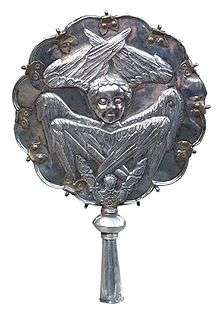Liturgical Fan (Orthodox Church)
Liturgical fans, flabella or ripidions (Greek ριπιδιον — fan), are hand fans used in the Orthodox Church during services.[1][2] Ripidions are carried by the altar servers at all processions with Eucharistic gifts and the Gospel book.[3]

In the Eastern Orthodox Church and Eastern Catholic Churches, the sacred fan (Greek: άγιον ριπίδιον, hagion ripidion, plural: άγια ριπίδια, hagia ripidia; sometimes εξαπτέρυγον, hexapterygon, plural: εξαπτέρυγα hexapteryga—literally, "six-winged"), have been used from the first centuries to the present day. It is generally made of metal, round, having the iconographic likeness of a seraph with six wings surrounding a face, and is set on the end of a pole. Fans of carved, gilded, or painted wood are also found. They are usually made in pairs. For historical use in the Western Church see flabellum.

The deacon, according to the Service Books, stands by the Holy Table (altar) to fan the Sacred Gifts by waving it gently over them from the time of the Offertory to the Communion—in the Liturgy of St. Basil he does this only during the Consecration. This originally served the purpose of keeping flying insects away from the Sacred Gifts. Nowadays, the Gifts are usually covered, shortly following their sanctification, whenever the priest or deacon does not have his hand immediately near them so, while this action of fanning is called for in the service books to this day, the deacon normally only does so on the day of his ordination. At his ordination, a deacon, receives the fan from the bishop with his vestments and service book and is presented to the people for them to exclaim "Axios!" (“worthy”) holding the fan, and then stands behind the Holy Table (altar) to fan the Sacred Gifts according to the otherwise archaic practice.
Among the Eastern Orthodox, the fans will be carried during the Great Entrance and at all processions; in the Russian churches they are often also used to honour a particularly sacred icon or relic. When not in use, the fans are usually kept in stands behind the Holy Table in the Greek tradition, and in the Slavic traditions may either be kept there or out of sight elsewhere in the altar. The latter is especially true in northern Russia, where, instead of the processional Cross and fans, icons of Christ and the Theotokos are usually placed behind the Holy Table.
Fans used in the Maronite, Oriental (e.g., Coptic, Armenian, Ethiopian), and Assyrian traditions are distinctive, having little hoops of metal or bells all around the circumference of the disks. At particularly solemn points of the liturgy, these are shaken gently to produce a tinkling and jingling sound, akin to the sound of multiple altar bells.